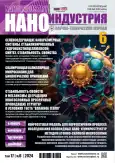Comparative analysis of the surface and antibacterial properties of cotton materials modified with silver and copper nanoparticles
- Authors: Farus O.A.1
-
Affiliations:
- Orenburg State Pedagogical University
- Issue: Vol 17, No 6 (2024)
- Pages: 356-362
- Section: Nanotechnologies
- URL: https://journals.eco-vector.com/1993-8578/article/view/639894
- DOI: https://doi.org/10.22184/1993-8578.2024.17.6.356.362
- ID: 639894
Cite item
Abstract
The work is devoted to the problem of fiber modification by silver nanoparticles (AgNPs) and copper (CuNPs). As part of the ongoing study, the modification of cotton fabric was carried out by impregnation with a controlled precipitation reaction, hydrazine was used as a reducing reagent. The remains of this reducing agent were completely washed off the material with distilled water. The introduction of silver and copper nanoparticles onto the surface of the material leads to a change in their biological activity. The results of the surface study using the ImageJ application show that in the resulting modified materials, such as XM/AgNPs and XM/SuNPs, nanoparticles are fixed on the surface of the material. The highest value of the coefficient of bactericidal activity is observed for a material of the XM/AgNPs type, which is expected, while it is important to take into account the lower cost of the initial reagents in the case of materials modified with copper nanoparticles.
Full Text
About the authors
O. A. Farus
Orenburg State Pedagogical University
Author for correspondence.
Email: farusok@yandex.ru
ORCID iD: 0000-0002-1426-6534
Cand. of Sci. (Chemistry), Docent
Russian Federation, OrenburgReferences
- Агафонов А.В., Галкина О.Л. Растворные технологии – новый путь нанофункционализации текстиля. Российский химический журнал. 2015. Т. 59. № 3. С. 96–101.
- Удегова Е.С., Гильдеева К.А., Рукосуева Т.В., Сьед Б. Антибактериальный эффект наночастиц металлов на антибиотикорезистентные штаммы бактерий. Инфекция и иммуните. 2021. Т. 11. № 4. С. 771–776. https://doi.org/10.15789/2220-7619-MNA-1359
- Антонова М.В., Красина И.В., Илюшина С.В. Методы придания антибактериальных свойств текстильным волокнам. Вестник Казанского технологического университета. 2014. Т. 17. № 18. С. 56–63.
- Бирюкова М.И., Юрков Г.Ю., Миргород Ю.А. Синтез наночастиц меди и их использование в модификации натуральных тканей. Физика волокнистых материа¬лов: структура, свойства, наукоемкие технологии и материалы (SMARTEX). 2012. № 1. С. 49–55.
- Телегеева П.Г., Ефременко Д.С., Телегеев Г.Д., Малюта С.С. Применение наночастиц в биомедицине. Biotechnologia Acta. 2013. Т. 6. № 2. С. 21–32.
- Бирюкова М.И., Юрков Г.Ю., Сырбу С.А., Таратанов Н.А. Синтез и структура наночастиц меди и их антимикробные свойства. Материаловедение. 2013. № 7. С. 33–39.
- Таусарова Б.Р., Рахимова С.М. Целлюлозные материалы, модифицированные наночастицами серебра, и изучение их антибактериальных свойств. Химия растительного сырья. 2020. № 2. С. 345–355. https://doi.org/10.14258/jcprm.2020025986
- Фарус О.А. Анализ структуры поверхности волокнистых композиционных материалов типа ЛМ/Ag 0 и оценка возможности их использования в качестве антибактериальных материалов. Интернет-журнал Науковедение. 2015. Т. 7. № 5(30). С. 165. https://doi.org/10.15862/74TVN 515
- Фарус О.А., Игнатьева К.Н. Перспективы использования волокнистых нанокомпозитных материалов для очистки воды в закрытых системах. Экологическая химия. 2018. Т. 27. № 6. С. 301–308.
- Шепелин А.П., Домотенко Л.В. Диско-диффузионный метод для определения чувствительности микроорганизмов к антибактериальным препаратам. Поликлиника. 2019. № 4–1. С. 2–5.
Supplementary files








